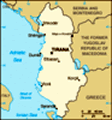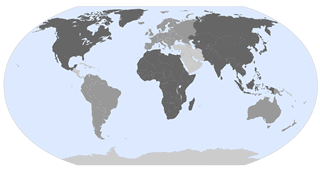Advertisement
Published: October 5th 2022
Monday - in the morning, after the previous evening's cloud-mist, the setting of the hotel looked positively idyllic. What a shame that the hotel breakfast was the worst of the trip - fried eggs which had been fried some time earlier and then just left out on a cold plate anyone? (OK, yes there were other things too but nothing appetising).
Dropping down the mountain side we stopped at the coastal town of Vlore for a coffee stop... and an opportunity for a nice pastry to make up for the appalling breakfast.
Flag Square in Vlore was where the Albanian flag was raised in 1912 when Albania became independent, represented by an impressive monument erected during the communist era. So, although the monument celebrated events in 1912 the figures shown, in pose and in dress style, are distinctly "communist triumphant" in design.
Vlore's other main claim to fame is in the Civil War of 1997 bought about by the collapse of widespread financial Ponzi or Pyramid schemes.
In essence, after the fall of communism in 1991/92 there was something of a financial free-market free for all. Several chancers, including government officials, set up "investment schemes" offering ridiculous
rates of investment return - 10 to 25% per month! 100%!
At its height, around 1996/97, two-thirds of Albania's population were invested in such schemes. People had sold their houses, invested monies from overseas,....
It was clearly not sustainable and the government pulled the plug on the schemes. The population collectively lost $1.2 billion, or $400 per person, at a time when monthly earnings were around $80.
After increasingly angry protests rioting broke out in Vlore leading to a countrywide civil war. During the unrest, January to July 1997, over 2000 people died. Eventually UN troops were sent in to restore order, and new elections were held.
From Vlore we travelled to Apollonia, another of the most important archaeological sites in Albania.
Founded in 585 BC, and dedicated to the god Apollo, it became Caesar's stronghold during the civil war with Pompey. The site contains around 1100 years of history, and was abandoned in the 5th C.
The most impressive feature on the site is the bouleuterion, a facade with 6 corinthian columns thought to date back to the 2nd C AD.
There are also the remains of an amphitheatre that is estimated
to have held up to 13,000 people, but its materials have pretty much been robbed out.
At its peak up to 60,000 inhabitants lived in the city
Only around 8% of the site has been excavated, and even that small percentage has yielded an impressive array of artefacts, displayed in the on-site museum.
Amongst these is a reconstructed bronze shield. When found it was in over 8100 pieces and it took around 27 years to reconstruct. After reconstruction it then just ended up in a cupboard in Tirana for several years before being "rediscovered".
Our overnight stop was at Berat, a fortress town, straddling the River Osumi overlooked by its castle above. Arrival timing was such that we could have a guided walk of the lower areas on both sides of the river in the late afternoon, and then a guide around the actual inhabited fortress in the next morning before moving on.
Dating back to Ottoman times the city is known as....
The one over one windows city (though the vernacular can also translate as the thousand windows city) because of the way the houses are built up the hill side, with lines of
windows looking over the river and look almost like one continuous building, and
The White City - not because so many of the houses are painted white but because the main building material is a very white stone.
The city had a very lively promenade area along the river lined, of course, with bars and restaurants, which were ideal for dinner that evening.
Tuesday morning was a couple of hours around the fortress itself. Alfred had offered on Monday to walk up with anyone who wanted to get up there that way.
In the morning everyone was on the bus for the drive up.
Berat Fortress, dating from 13th C, is inhabited within its boundary walls. There are many houses and streets. Also many churches and mosques in various stages of complete or decayed - up to 20 or more at some stages.
We visited the Church of Santa Maria, built in 1797 over the remains of an older church. It is one of the most representative monuments of post-Byzantine architecture in Berat.
The iconography and frescoes in there was pretty complete, along with 14th C wooden carvings. In addition there was also (another)
attached icon museum.
The rest of what we saw up there is either viewable only from the outside, or in ruins. The later included the Red Mosque, the oldest mosque in Albania, which is just a few levels of bricks - hence its name - but an upstanding minaret. And an enormous Ottoman water cistern.
As we all sat up top, having a coffee break, we were rewarded at last with the spotting of an eagle flying overhead.
Our final stretch of coastal driving took us to Durres, Albania's main port. Apparently there are/were several miles of nice beaches in the area but port development had put paid to that.
The port was originally founded in 627 BC by the Greeks, and was called Epidamnos. It was later plundered and conquered by the Illyrians, Romans, Normans, Venetians, and Serbs - and now modern day developers - which all shows in its wide variety of building influences.
Hemmed in by, relatively, modern buildings is a Roman Amphitheatre, only discovered in 1966. Although on three sides there are buildings practically up to its boundary, and the lower side has little more breathing space, when it was built
the sea was much closer and there were no structures between the two.
The seaward side when built was open so the view of the stage and then the sea beyond for the up to 20,000 spectators would have been impressive, a bit like the Minack Theatre in Cornwall.
It is thought that, like other amphitheatre /colosseums it would have been used for entertainment such as artistic shows, gladiator and animal fights etc, though no direct archaeological evidence eg bones, has been found.
The problem is the state and location of the site. The surrounding buildings are really hemming it in. There was some excavation along the line of the entrance tunnel but that had to stop as it had led to beneath the houses above. It has World Heritage Site potential but not whilst it is endangered the way it is.
After a coffee and cake break there was briefly time to get to the waterfront, such as it is. An interesting statue with three individual figures - Mick Jagger, Bob Dylan and a third unidentified. Some research showed that until 2 weeks ago there was a 4th, Tina Turner, now stolen, and that the
unknown was John Lennon whose distinctive round glasses had been removed some time ago.
Leaving the coast behind we headed inland to slightly north of Tirana and the mountainside town of Kruje, birthplace of Skanderbeg. It was an impressive site as we approached, with the city on a high plateau/"ledge" and then itself backed by more towering cliffs.
Sometime during the driving the question of Norman Wisdom, English slapstick comedian, was asked. You may or may not be aware that Norman was something of a folk hero in Albania.
During the communist regime entertainment was heavily controlled. Few people had televisions, initially because of the lack of electricity but then also because of control over who could have such TVs. What could be broadcast was heavily regulated too.
But Enver Hoxha saw in Norman's downtrodden characters elements of the working classes being successful against the ruling classes. And so Norman's films were shown in Albania and he became a national hero. He was given the Freedom of Tirana. When England played Tirana at football he appeared in an half Albania /half England shirt and it is said he got a bigger welcome than David Beckham.
When he died in 2010 there was a day of mourning/national holiday in the country
Best hotel and breakfast of the Explore tour on that final night in Kruje. Lovely views over the flatland below, and as far as the sea glinting in the distance some 30 km or so away. The only downside? Our 5th floor room put us level with and barely 50 feet from the mosque minaret loudspeakers that were used for the call to prayer.... at 5.30 am!!!
Free time in Kruje gave us a chance to walk through the "bazaar", which would have certainly have been more interesting if it hadn't been lined with "souvenir shops" all selling the same mass produced Chinese tat, and up into the castle confines. Once there though, the only ancient building is a Venetian tower, looking like it's only standing because of the extensive metal cabling holding it together.
And that, except for a final group meal, was it for the Explore tour, although most of us were on the same Explore bus the following day to the airport. As we don't leave until Friday we essentially "hitched" a ride on the bus to the airport

 Apollonia
Apollonia
Bride/groom visit sites in the month before their wedding to get wedding photosso that we could then use an airport/Tirana shuttle to get into the city where we have another couple of night's stay - EasyJet changed our return flight from Wednesday to Tuesday so we, in turn, re-changed it to the next available later flight which is Friday.
Things seen a lot of, Part 3
Cyclists riding against the traffic direction
Treatment centres - dental, plastic surgery.....
Industrial places selling large slabs of marble and other such materials
Hotels/restaurants built to look like mini castles
Tree nurseries - selling very large olive trees, conifers etc in even larger pots.
Advertisement
Tot: 0.088s; Tpl: 0.013s; cc: 7; qc: 28; dbt: 0.0543s; 1; m:domysql w:travelblog (10.17.0.13); sld: 1;
; mem: 1.1mb




















